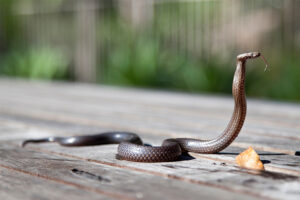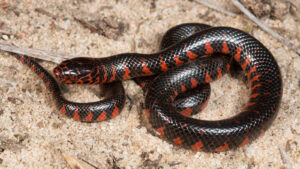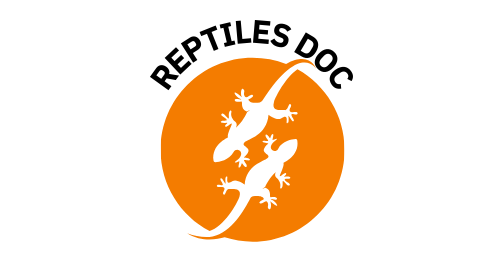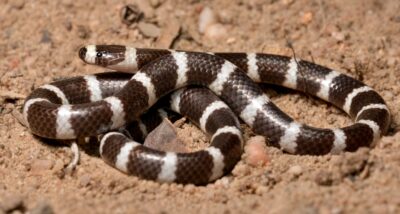Legends of bizarre and mystical creatures have been passed down through generations, often sparking curiosity and skepticism. Among these curious tales is the story of a snake that can allegedly roll itself into a hoop and chase after its prey. Are hoop snakes real?
This unusual creature has sparked debates in various cultures, with some swearing by its existence while others dismiss it as pure fantasy. The idea of a snake capable of such acrobatics seems like something out of a myth, but the intrigue around it persists, leaving many to wonder whether there could be any truth to this strange phenomenon.
Are Hoop Snakes Real?

The hoop snake is a legendary creature that has fascinated people for generations. According to folklore, this snake is capable of biting its own tail to form a perfect hoop and then rolling like a wheel to chase down its prey. Some versions of the myth even claim that it has a venomous stinger on its tail, which it uses to deliver a fatal blow when it catches its target. Stories of hoop snakes have been told in the United States, Canada, and even Australia, often passed down as tall tales meant to entertain or spook listeners.
Despite the widespread nature of these stories, there is no scientific evidence that hoop snakes actually exist. No snake has ever been documented rolling in such a way, and no credible sightings have been recorded.
Many experts believe that the hoop snake legend may have originated from misidentifications of real animals, such as the Eastern Coachwhip snake, which is known for its speed and agility. Others suggest that the story may have evolved from exaggerated accounts of the behavior of certain snakes, like the mud snake, which sometimes curls its body in defensive postures.
Folklore often has a way of making the impossible seem real, and the hoop snake is no exception. While it is a fun and fascinating myth, science tells us that snakes simply don’t have the physical structure or behavior necessary to roll like a wheel. So, as much as the idea of a rolling, tail-stinging snake might make for an exciting story, it remains just that—a story.
Are There Any Recorded Sightings of Hoop Snakes?
There are numerous anecdotal reports of hoop snake sightings, but none have ever been verified by scientists or wildlife experts. Most stories come from rural areas in North America and Australia, often passed down through generations as part of local folklore.
People who claim to have seen a hoop snake describe it rolling at high speeds down hills or across open fields, sometimes in pursuit of prey or a fleeing person. However, no physical evidence—such as photographs, videos, or specimens—has ever been provided to support these claims.
Many experts believe that supposed sightings of hoop snakes could be cases of mistaken identity. Snakes like the Eastern Coachwhip or the Black Racer are extremely fast and may appear to be rolling or tumbling when moving at high speed. Additionally, some snakes, like mud snakes, naturally curl their bodies into a loop, which may have contributed to the legend. Without concrete proof, hoop snake sightings remain part of folklore rather than scientific fact.
Why Do Myths Like the Hoop Snake Persist?

Myths like the hoop snake persist for several reasons, ranging from cultural storytelling to the way our brains process unusual or unexplained events. These stories are often passed down through generations, evolving with each retelling and becoming deeply embedded in local folklore. Below are some key reasons why such myths continue to thrive:
- Oral Tradition and Storytelling
Many myths, including that of the hoop snake, have been passed down through word of mouth. Before modern media, storytelling was a primary form of entertainment, and exaggeration helped make tales more engaging. Each generation added its own twist, keeping the legend alive.
- Misidentification of Real Animals
Some people who claim to have seen a hoop snake may have actually encountered a real snake behaving in an unusual way. Fast-moving snakes like the Coachwhip or Black Racer can create the illusion of rolling, while certain species naturally curl their bodies, reinforcing the myth.
- Psychological Bias and Expectation
When people hear about legendary creatures, they may be more likely to believe they’ve seen one. This is known as confirmation bias—where the brain interprets ambiguous or unclear sightings as proof of something they already believe to be true.
- Fear and Fascination with the Unknown
Snakes have been both feared and admired throughout history. The idea of a snake that can roll at high speeds and strike with its tail adds an extra level of danger and excitement, making the myth more memorable and likely to be repeated.
- Entertainment and Folklore Value
Tall tales and myths are an important part of culture, especially in rural communities where storytelling has long been a form of social bonding. Legends like the hoop snake are fun to tell and hear, helping to keep them alive even in modern times.
While science has never found any evidence of hoop snakes, the myth continues to thrive because of storytelling, misidentification, psychological factors, and human fascination with the unknown. Like many legends, the hoop snake is a testament to the power of folklore and our love for a good, mysterious tale.
Conclusion
Hoop snakes have long been a part of folklore, with tales describing them as snakes that bite their own tails and roll like a wheel to chase prey. Despite these intriguing stories, there is no scientific evidence to support their existence.
Are hoop snakes real? No credible sightings or biological studies confirm such a creature, and the idea remains firmly in the realm of myth and legend. Like many cryptids, the hoop snake continues to capture imaginations, but reality suggests it is just another fascinating tale passed down through generations.

